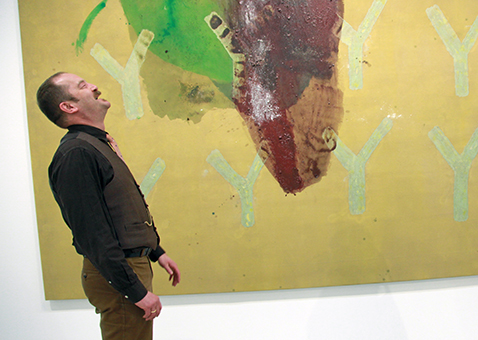wanderlust
The Art Of Curating: A Laughing Matter?

Many layers of the art world are oft overlooked when viewing an exhibition. Admittedly while walking amongst the works in a show, I am primarily concerned with the artist in question, and I too frequently fail to consider the roles of other people involved in the exhibition, such as the gallery director, the curator or the people who installed the work. Yet recently I got curious: how do such figures impact an exhibition? I set out to interview a curator at an established art instiution to find out, and I immediately knew just the person and place––Berlinische Galerie‘s curator Dr. Heinz Stahlhut.
We met at Berlinische Galerie and headed for the room displaying works by the winner of the Fred Thieler-Prize For Painting 2013, which this year has been awarded to Sergej Jensen. Dressed smartly in suit trousers, a shirt and waistcoat, it is clear that Stahlhut feels at home in the environment, and he acknowledges all the gallery workers warmly as we pass through the building. Reaching the room with Jensen’s work we start to meander around the paintings, and the questions begin.
BAPs: Could you tell me about the process of setting up the current show?
DHS: I think for an artist like Sergej Jensen who works a lot with the space in which he exhibits our role is much more that of an organizer––to bring him into contact with the people he needs for installing the work, discussing who could be the author for the catalogue and things like that. He chose the paintings he wanted to bring; many of them were produced for the show. He moved to NY just recently and some of the works were produced there, but he also brought older paintings which he then installed with the new paintings.

BAPs: Do you feel that this is always the case––that the curator plays more the role of an organizer?
DHS: No, in other cases, for example the Hödicke exhibition [which we reviewed here], I much more chose the paintings I wanted to show and developed the concept of giving the overview of the artist. In this retrospective we also dealt with the paintings we have in our collection so it would develop the content of such an exhibition––such a show is an opportunity to show your acquisitions from the past decades.
BAPs: What made you want to be a curator initially?
DHS: Very early in my studies I did internships in museums. I began to study in Berlin at the Freie Universität and then moved to Basel to finish my studies there. Then I did several internships in museums all over Germany, and I began to like very much that you can deal with a lot of different people because you have to deal with artists, your colleagues, people who help you technically install an exhibition, the guys who make the catalogue and so on. This kind of multitude of contact with very different people is something which I like very much.
Be the first to write a comment.
Your feedback
